WHITE PLAINS Book Tour: Part 2
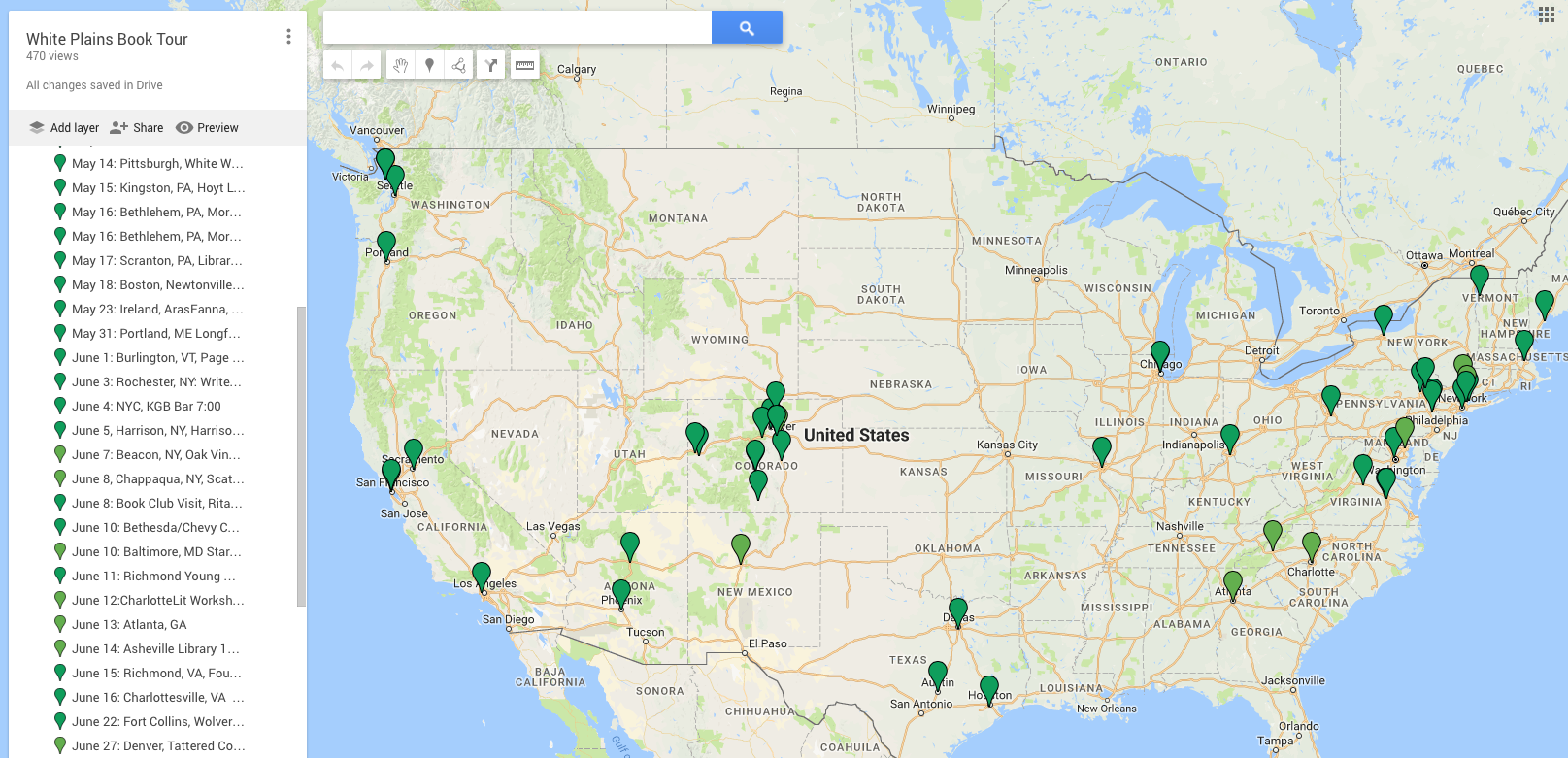
or, Dave’s Top Ten Tips on How to Organize a Book Tour
After the main part of my book tour ended—the string of southwest, Midwest, and East Coast visits that included a run of 34 appearances in 34 days) I came home, spent some long-overdue quality time with my wife, set about making up for my neglect of the yard, and reflected on the highlights and lowlights of the tour thus far. I then finished up with readings in the northwest (Seattle and Portland), Chicago, western Colorado, Flagstaff AZ, and Port Townsend, WA. Since then, aside from some random invitations to read/sign elsewhere, I have since been focused on finishing my next novel.
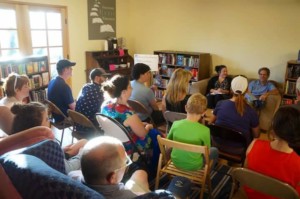 So: after fifty appearances at a variety of venues (independent bookstores, libraries, pubs, and even a diner in Binghamton) and 8000 miles of driving, all organized by yours truly, I feel as if I may have gained some wisdom as to how to go about publicizing one’s book, and may therefore convey some sage(ish) advice for those of you who are about to (or hope to) publish your first book someday. Because it’s not enough just to publish your book these days. The main reason why we want to publish out books, after all—whether subconsciously or consciously–is so that others may read it. And how can others read it if they don’t know it exists?
So: after fifty appearances at a variety of venues (independent bookstores, libraries, pubs, and even a diner in Binghamton) and 8000 miles of driving, all organized by yours truly, I feel as if I may have gained some wisdom as to how to go about publicizing one’s book, and may therefore convey some sage(ish) advice for those of you who are about to (or hope to) publish your first book someday. Because it’s not enough just to publish your book these days. The main reason why we want to publish out books, after all—whether subconsciously or consciously–is so that others may read it. And how can others read it if they don’t know it exists?
So you have to promote your book.
And one way to do just that is to go on a book tour. (There are other ways, of course, including online, which I will leave to my friend Rachel Weaver to tell you about; Rachel has sold over 20,000 copies of her small-press book, mostly by way of her persistent research and online connections.) Whether you publish with a small press (as I did), are mid-listed at a big publishing house, or self-publish, if you want a big book tour, it’s up to you. Fortunately, the Events managers at bookstores across this great country are, for the most part (with a few cranky exceptions) kind and wonderful, and, if you can guarantee an audience, they will help you to plan and promote your reading.
Unfortunately, they are also very busy people, so you still have to do most of the work yourself.
One important note before I begin: I did the entire tour at no cost. What I mean is, I didn’t lose money. I ran a Kickstarter campaign months beforehand and raised over $4000. During the tour I would run a workshop, make a few hundred dollars, then use that money to pay for my Airbnbs, gas, and food. Or I would sell my own books at a reading, then use that money to buy dinner. And so on. It can be done.
 Here now, my Top Ten Book Tour Tips.
Here now, my Top Ten Book Tour Tips.
- Start planning way more in advance than you think you have to.
Your book launch should be planned at least six months in advance of the publication date, and your book’s “window of excitement” is three months before and three months after its pub date. Get started now–by doing the following:
- On social media, add friends in the reading/writing world, or cultivate the writing friendships you already have; you never know which of your new friends will turn into an ally as you try to promote your book—you know, that book you will be publishing next year or the year after. (It’s going to happen. Plan on it. Or to put it differently, if you believe it’s not going to happen, then it won’t. Or it will, and you won’t be prepared. Either way, boo to you.) BTW, it’s not enough simply to friend-request people and “like” their posts; you need to chat with them, comment on their posts, start a dialogue. Make friends, in other words. Not with your agenda in mind, but simply to be friends with another nice person in the writing world. On the whole, they’re very good people.
- Create, or make more professional, your website. And start publishing blog posts and publicizing them in order direct people to your site. (Do not post your words or images directly to Facebook, Tumblr, or Twitter; instead, post your website link to the blog post.) When it becomes a habit for people to go to your site, imagine how nice it will be when they see, on your home page, your book-cover image and the link to pre-order it. If you wait for your book to be published before posting things to your site, then you’ll have three people going to it when your book is published. If you start now, you’ll have hundreds. So start now. (All of that is a consolidated version of the advice my friend and website manager, Paul Matthew Carr at webworkz, has given me, and I can tell you that it works. After all, you’re reading this on my website, aren’t you?)
- Practice reading your work. Go to open mics and step up to the plate. Do it again and again. Because you don’t want your first public reading to be the first stop on your book tour. That could get ugly.
Once you actually get a book contract, immediately ask people to blurb your manuscript. Then prepare your “one sheet” (the one-page .pdf that contains the description of your book, an image of the cover, your bio, and a few blurbs) that you will send to bookstore events managers when you propose a reading.
- Start booking your tour.
Bookstores are booked for readings and signings six months in advance, but the good news is that there are about a thousand more independent bookstores now than there were ten years ago. Almost every American city has an independent bookstore now, if not several, and every one of them has someone in charge of events. Find out who that person is (either from their website, or simply by calling and asking) and map this baby out.
Here’s how I did it:
First, I booked my “anchors”: readings at independent bookstores.
I’m a college professor, so I planned my tour for the summer. (That was a mistake, by the way. Generally speaking, people are either on vacation or too hot to go to the bookstore in the summer. In the fall, on the other hand, we’ve been conditioned to buy stuff. So I would recommend touring in the fall.) And I knew I would be driving. So I organized the tour geographically, beginning right after finals week at my two hometown bookstores (in Boulder and Denver), making my way (meanderingly) toward my original hometown in New York, then traveling down the east coast to my best friend’s home in Virginia. So: following the first stop in the mountains south of Denver, the next logical stop was Albuquerque, then east of Albuquerque is Dallas, then Austin and Houston, then north to St. Louis, then Cincinnati, then Pittsburgh, and so on. I contacted the independent bookstores in each city, knowing what date I would arriving there. I was persistent, and never failed to book a reading in a city, even where I had no connections. In Dallas, for example, two bookstores said no (or said nothing, which in the rude era we are living in, means no), but Wild Detectives (one of the coolest little bookstores in the country, as it turns out) said yes. (And some bookstores charge fees to hold readings, so I skipped those.) I mapped it all out, the pinpoints on my Google map red (if I asked but hadn’t heard back), then yellow (when there was a tentative “Sure, if you can guarantee an audience of at least ten people” type of response) and then green (when it was booked).
So, how did I guarantee an audience of ten or fifteen people in cities where I don’t know anyone?
Reading partners.
I looked up local authors in the cities where I knew no one, found those who had new books out, and asked them to read with me. My thinking was that they would invite their friends and family, et voila! An audience of ten to fifteen people, some of whom might end up buying my book.
Only this didn’t work all the time, because several writers I read with brought absolutely nobody to the reading. (As it turns out, some writers are simply awful at asking friends to come to their public  appearances.) So next time, I will ask writer who aren’t shy about promoting themselves. But most of these arrangements worked out really well: in Houston, for example (where I know only one person, and she was away on vacation the day of my reading), I asked Melissa Studdard, a poet whose work I admire, to read with me, and she wound up drawing an audience of at least fifteen that night. So I sold a bunch of books and had the privilege of listening to Melissa read her powerful work.
appearances.) So next time, I will ask writer who aren’t shy about promoting themselves. But most of these arrangements worked out really well: in Houston, for example (where I know only one person, and she was away on vacation the day of my reading), I asked Melissa Studdard, a poet whose work I admire, to read with me, and she wound up drawing an audience of at least fifteen that night. So I sold a bunch of books and had the privilege of listening to Melissa read her powerful work.
- Now is not the time to be shy.
People rarely come to readings at bookstores if they don’t know the writer. They come if it’s one of their favorite authors (which I knew I would not be, since I’m a debut novelist), or if a friend of theirs is reading. But just as nobody will know you have a book unless you tell them about it, your friends won’t know about the reading unless you tell them about it. So it’s your job to drag them out of their house.
So, how to do this? Facebook is one option. About eight years ago, I joined Facebook with one purpose: to make friends with readers and writers who might someday buy my book—if I ever got a book contract, that is. It’s ended up being much more than that—I’ve reconnected with old friends, made new ones, and learned so much from my feed (as it turns out, writers are smart people who post smart things)—but it also worked out the way I originally wanted it to: by the time my book tour was launched, I had over 2,000 “friends” I could invite to my readings.
I did so least effectively by simply posting about a reading.
I did so somewhat effectively by creating Facebook event pages, or using the bookstores’ event pages, and inviting friends who live in that city to the event. (Search for “Friends who live in Pittsburgh,” for example, and the folks who live in that fair city will pop up in a convenient list.)
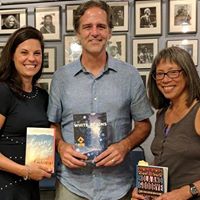 But I did so most effectively by personally inviting friends who live in the city where I would be reading, one friend or acquaintance at a time—either by way of Facebook Messenger or personal email.
But I did so most effectively by personally inviting friends who live in the city where I would be reading, one friend or acquaintance at a time—either by way of Facebook Messenger or personal email.
- Seek out alternative sites.
People don’t always enjoy going to bookstores for a quiet, staid, Dear-God-I-knew-this-would-last-longer-than-an-hour reading, followed by an endless Q&A and then a line to get your book signed. Sometimes going to a pub, where you can have a pint with a friend while listening to a reading, feels much more inviting. Or a coffee shop. Or a friend’s house.
Side note: Barnes and Noble was worthless. They simply didn’t care about a small-time writer like me; they cared only about my distributor. One example: my novel is partially set in White Plains, NY, and is titled WHITE PLAINS. The only bookstore in the city of White Plains, NY is a Barnes & Noble. So when I called their Events manager to ask if I could hold a reading there, thinking This will be a no-brainer, she asked about my distributor and then said she’d think about it. When I called back a few weeks later, and then emailed, she didn’t respond. I told her (on the phone and in the email) that I grew up in Harrison (the town that borders White Plains to the east); that many members of my family, and many of my high-school friends, still live there; that I could guarantee an audience of at least forty or fifty people. Forty or fifty book sales, in other words.
Nothing. And similar queries at other Barnes & Noble outlets in other cities garnered the same result.
But as it turns out, I didn’t need them. And I much prefer indy bookstores and libraries anyway.
So I arranged for a reading at the Harrison Library, drew over fifty people, and pocketed the profits myself. And I gave readings at three other indy bookstores near White Plains.
So there, B&N.
Anyway, seek out alternative sites to bookstores: libraries, cafes, pubs. Or–my favorite, even though I didn’t have one–a salon at a friend’s house. You’ll draw a bigger crowd and have more fun.
- Re. the book launch: Go Big or Go Home.
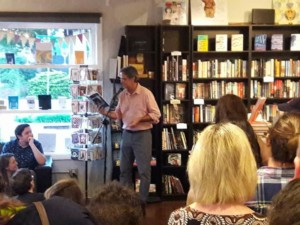 Your book launch will be your best opportunity to sell books, so do it right. And that doesn’t mean spending a lot of money. (Your publisher will probably pay for it, but if not, you don’t have to spend much: hold it at a bar (or if you’re lucky enough, as I am, to have a bookstore in your hometown that sells beer and wine, a book bar in other words) so people can buy their own drinks.
Your book launch will be your best opportunity to sell books, so do it right. And that doesn’t mean spending a lot of money. (Your publisher will probably pay for it, but if not, you don’t have to spend much: hold it at a bar (or if you’re lucky enough, as I am, to have a bookstore in your hometown that sells beer and wine, a book bar in other words) so people can buy their own drinks.
And go crazy: invite everyone. Family, friends, Facebook acquaintances, former students, colleagues, classmates, etc. Everyone. Pack the joint. If you don’t invite everyone to the launch of your book, what (okay, besides your wedding) will you be inviting everyone to? Your Linkedin work anniversary? Your parole hearing?
This is your moment, in other words. You have a book. Celebrate it like there’s no tomorrow. Wear a fun outfit, enjoy the attention, and treat it for what it is: a party, not a reading. (In other words, keep the reading short—as in five minutes–and do a lot of hand-shaking and hugging.)
But don’t have just one launch. Rather, treat any reading at a place where you have a lot of friends (your hometown, your college town) as a second or third launch.
I had my book launch at the BookBar, about a mile from my home in Denver, and it didn’t cost much, since everyone could buy their own drinks. Best launch I could ever hope for, packed with dear friends and well-wishers. I had another “launch” in New York, at that reading in my hometown library, and about fifteen members of my family were there, some former high-school classmates, my mother’s friends–again a festive atmosphere, with food and drinks and plenty of good cheer–and I sold even more books there than I did at my book launch.
- Don’t give away your book. Not. A. Single. One.
You’ll be able to buy your own books at 50% per book, so that if you sell any yourself, you’ll make 50% profit. (For example, my book retails for $16, so I pay my publisher $8 per book and sell them for $16. So you make dollars instead of pennies per book sold. But keep in mind those sales won’t “count” toward your official book sales that publishers and book buyers track. So when you seek an agent or publisher for your second book, and they look at the sales numbers of your first book, they won’t be impressed if you’ve sold most of your books yourself.)
In any case, before the book tour, load up on your own books. I embarked with 60 in my trunk and before I hit the mid-way point I had to order the delivery of two more boxes, and then ordered another three boxes before it was over. (And I had to pay for delivery, which is expensive.) Why do you need so many of your own books? Because if you follow the above advice and have readings at venues other than bookstores, then who’s going to sell your books?
You are.
So if you give a book away, you’re giving away money that should be in your wallet. Eight dollars, in my case, or fifteen if it’s a hard cover. Don’t do it. You worked so hard to create this product; don’t give it away.
P.S. You’ll need to get a credit-card reader, like a Square (for iPhones) or PayPal reader, that attaches to your smart phone or iPad, and you’ll need to put it in a place where you’ll never lose it. I put everything important in my backpack, and I brought my pack to every reading, stuffed with my swag. Speaking of swag . . .
- Got swag?
Once you receive the .pdf of your book cover, go to vistaprint.com or some other cheap printing company and make business cards, thank-you cards,  mini-posters—whatever you want—with your book-cover image on it. Take these with you wherever you go.
mini-posters—whatever you want—with your book-cover image on it. Take these with you wherever you go.
- How do you get to Carnegie Hall?
Practice, practice, practice.
(Sorry.)
A few weeks before the tour began, my wife Cynthia had the brilliant idea of hosting two parties so that I could practice my public-reading skills. We invited some well-read friends, fed them pizza and drinks, and then forced them to sit through three twenty-minute readings (so I had six practice readings), pausing after each as they wrote critiques on note cards. This served three purposes:
- It gave me the opportunity to practice reading my own words—to people who were sitting in front of me, staring at me. Very different from teaching in front of a classroom or reading someone else’s words.
- As a soft-spoken person who often mutes his words (out of embarrassment that you even have to listen to me), I needed to practice speaking in public. Fortunately for me, I’m friends with Communication professor, playwright, actor, producer, and director Janna Goodwin, who gave me a few simple tips—projecting my voice to the back row, breathing fully during paragraph breaks, not speaking quietly just because there was a microphone in front of me—so by the time I hit the road, I was in much better public-speaking shape than I had been before.
- I received immediate feedback on what were the most effective passages of my book to read. This is no small matter. As I discovered on the road, there is a direct correlation between the passage the author reads and the number of book sales. Read a passage narrated in a lively voice and containing lots of tension, and people will think, “I’d like to read more of that.” Read a really “deep” passage that shows off the beauty of your prose, and . . . crickets. Reading your book excerpts out loud to an audience is the only way to tell the difference. As an example, the chapter of my book that everyone seems to find most interesting when they read it (one in which the main character gets caught in a blizzard on his drive over a mountain pass) is not one that, when I read from it at a reading, generated the most interest in buying the book; whereas a not-very-important transitional chapter (in which the main character’s sister tells us how the main character has just skipped town) proved to be the most popular at my readings, both in terms of the audience’s reception of it and in terms of my book sales afterwards.
At these two parties I received invaluable advice from everyone, without exception, but the best was from my friend Fabrice, who told me I really need to read with more passion. “Read as if you are in love with your own words,” he said. I had been embarrassed to read my work, and it had showed. Fabrice advised me to pretend my own work was the work of a writer I loved. This changed everything for me. Subsequently, before every reading on my book tour, I told myself to love my words, and that simple piece of advice helped me immensely.
Meanwhile, every time I drove to or from work, I was interviewed by an imaginary radio host or asked a question during an imaginary Q&A.
How much of this book is about your own life?
Who are the writers you have been influenced by?
Why is your main character such an idiot?
I ignored the looks from nearby drivers and practiced responding to such questions, animating my voice and not saying “Um.” Again and again.
- Multi-Task
There were very few stops on my tour where the only thing I did was give a reading. More typically, once I had scheduled my “anchor” event (a reading at a bookstore), then I researched that city to see if there was a writer’s workshop organization where I could teach a workshop. (Note: it’s good to have one or two go-to workshop topics you can teach, with a theme that appeals to beginning writers). Such organizations typically pay the instructor about 50% of the fee, so at a couple of workshops I made about $600 each. I also tried to get a radio interview before my reading took place, to generate an audience for the reading; or a classroom visit, if a teacher I know lived in the city. And I checked to see if anyone I knew in that city was a member of a book club I could visit.
Book clubs are golden. Book club members love having authors visit them, and you’ll sell more books than you would at a typical bookstore reading. Thus it was well worth it for me, for example, to drive four hours to Atlanta from Charlotte solely to visit my former neighbor’s book club, since she had brought together a few local clubs (over twenty members), and they all pre-ordered my book months before my visit. When I arrived, Janice had organized a big book-club meeting for me, and also surprised me with a birthday cake. (Thank you, Janice!) 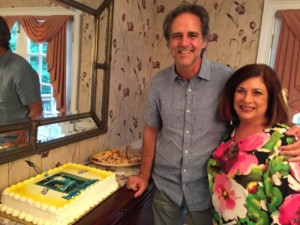 And I added onto that visit a drink with two of my most beloved former students, Reniece and Ashleigh, who now live in Atlanta.
And I added onto that visit a drink with two of my most beloved former students, Reniece and Ashleigh, who now live in Atlanta.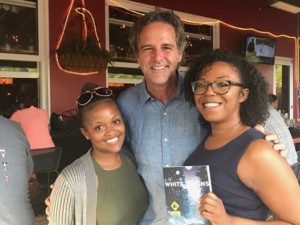
That’s because I would also seek out former students or friends in the area, so see if they wanted to have a beer or coffee with me before or after the reading. For one thing, they’re my friends, some of whom I haven’t seen in over thirty years, and these days I am seeking out opportunities for joy; and for another, they usually bought my book. My favorite of these visits was at a diner in Binghamton, where I stopped on my way from Rochester, NY to New York City to have a late breakfast with my college buddies Vinnie Subik, Frank McHugh, and David Cohn. They in turn invited their girlfriends, parents, and friends, so we wound up having a big boisterous breakfast, after which all twelve of them bought my book—more book sales, in other words, than several of my bookstore readings.
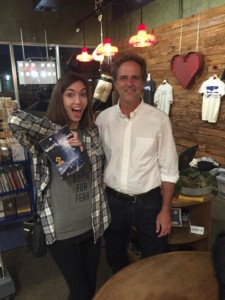 And needless to say, once I connected with an old friend or former student, they usually came to the reading—so they beefed up the audience. And that made the readings more fun. And isn’t that
And needless to say, once I connected with an old friend or former student, they usually came to the reading—so they beefed up the audience. And that made the readings more fun. And isn’t that 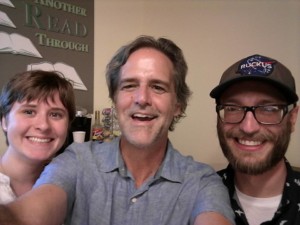 the whole idea, to have fun? People who come to book signings and readings are rarely in a bad mood; everyone loves to be read to; nobody will show up to heckle you. So you should enjoy it, and afterwards spend time with your friends.
the whole idea, to have fun? People who come to book signings and readings are rarely in a bad mood; everyone loves to be read to; nobody will show up to heckle you. So you should enjoy it, and afterwards spend time with your friends.
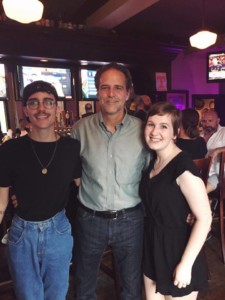 In fact, the most successful book tour I can think of would involve not reading at bookstores but traveling from town to town visiting book clubs and reading at friends’ houses. I didn’t ask any friends to host readings this time around—I didn’t want them to feel obligated—but I should have. When a friend hosts a salon for you in their house, then all their friends show up, and they all get a little tipsy. And when people get a little tipsy, they end up buying your book.
In fact, the most successful book tour I can think of would involve not reading at bookstores but traveling from town to town visiting book clubs and reading at friends’ houses. I didn’t ask any friends to host readings this time around—I didn’t want them to feel obligated—but I should have. When a friend hosts a salon for you in their house, then all their friends show up, and they all get a little tipsy. And when people get a little tipsy, they end up buying your book.
- Follow Up.
As my wife can tell you, I’m not a thank-you-note kind of person, but for the tour, I tried to be more like Cynthia (because she’s a lot nicer than I am). I had cards made (again, Vistaprint) with the image of my book cover on the front, bought 100 stamps, and sent everyone a thank-you note within a week or two following my reading. Because it’s nice to be nice. And when my next book comes out, I want them to welcome me back.
Bonus Tip: It’s all tax-deductible.
All of it. The government gives you a per diem for food (I never once spent my daily allotment); you can deduct the cost of hotels and Airbnbs; any promotional costs, publicity costs, entertainment expenses; everything. Also, you get 55 cents per mile; and I drove 8,000 miles. You do the math.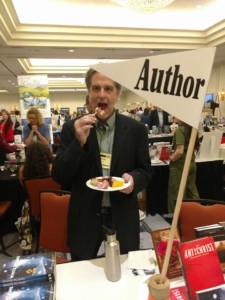
My Final Takeaway
The old-fashioned way still works. There are effective ways to use social media to promote your book, and there’s plenty of advice out there about how to do so. But it certainly does NOT work to spambot-bombard people with ads about your special giveaways or to push the book. I have seen hundreds of these, and I have never bought a single book, not even for 99 cents today only. But I have purchased many (over twenty, I’d estimate) books written by friends I’ve made over Twitter or Facebook—books I would likely never heard about had I not (very grudgingly) opened a Twitter account and Facebook account and come to know these wonderful folks. And that happened simply by way of conversations, not by “likes.” “Likes” are nice, but they do very little to cultivate relationships. It’s when I’ve commented on a stranger’s post, and that stranger commented back, that that stranger became a friend. And one of the great joys of the book tour was when I would meet someone in person whom I had “friended” on social media.
Remember: Your friends are your friends—they really want to help you to sell your book.
This is probably the one time in your life you are going to ask something of your friends, and that is to help you to promote your book. So not so much, “Hey, I’m giving a reading. If you’re not too busy, I’d love to see you” but
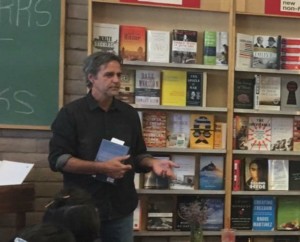 “I have a book! Please come to the bookstore for my reading and please bring three of your friends.”
“I have a book! Please come to the bookstore for my reading and please bring three of your friends.”
Then “I’m so glad you’re coming—can you re-post this or invite a few readers/writers you know in the area.”
Or (to your very dear friends/family members): “Is there any chance you could host a party for me when I’m in town?”
There you have it: that’s all I know (or all I can think of right now) about planning a book tour. Have I left something out? Feel free to contact me and ask away. Or better still, subscribe to my newsletter (at the bottom of this page) and receive my monthly emails containing news, information and general good cheer, and email me as often as you like.


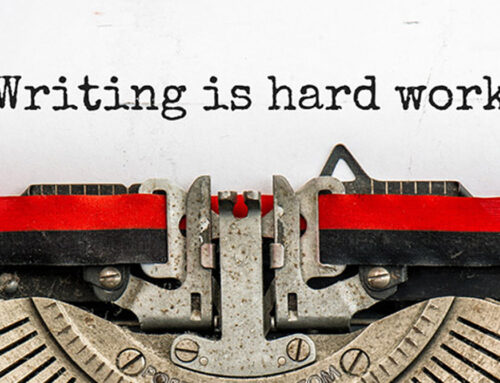

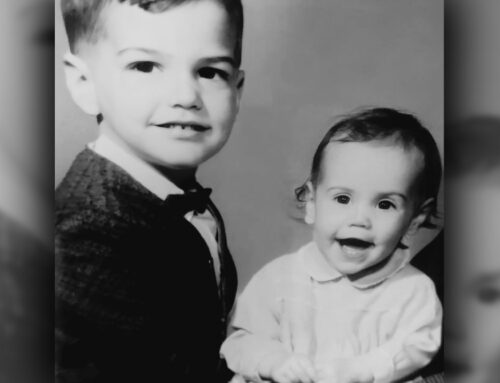
I still feel bad that I was on vacation when you came to town. But I’m glad it all worked out for you. Next time…. ;-)
Certainly not your fault, Viv, but I missed seeing you. Next time will be a longer visit anyway–I was only in town for a day.
Thanks so much, David. This is golden. I really like your relational approach, which is more human than “Hi! Buy my book!” I’ve made a point of avoiding Twitter (How much more noise do I need in my life?), but I like the way you use it. Could you go over your approach in more detail? (That might be another blog post topic.)
Thanks, Lynette, and sure, let’s chat about Twitter! :-)
Very interesting and detailed. So weird that the B&N in White Plains wouldn’t invite you for a reading! Their loss.
Nice to read about your thought process for how you planned this out. I am happy I was able to make it to one of your readings. :-)
Thanks, Jim!
Just having a stroll through your website, David. Looks gorgeous! And thanks for sharing your hard-won wisdom and reminder of the importance of TENACITY. . Well done, my friend.
(REALLY delayed reaction:) Thanks, Heather!